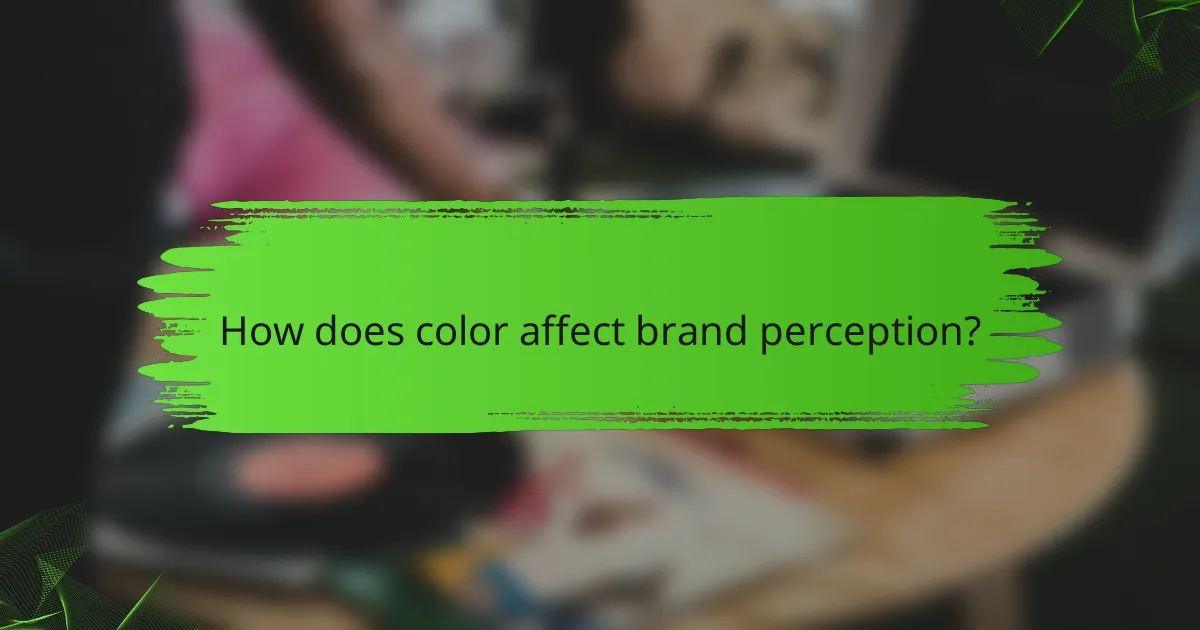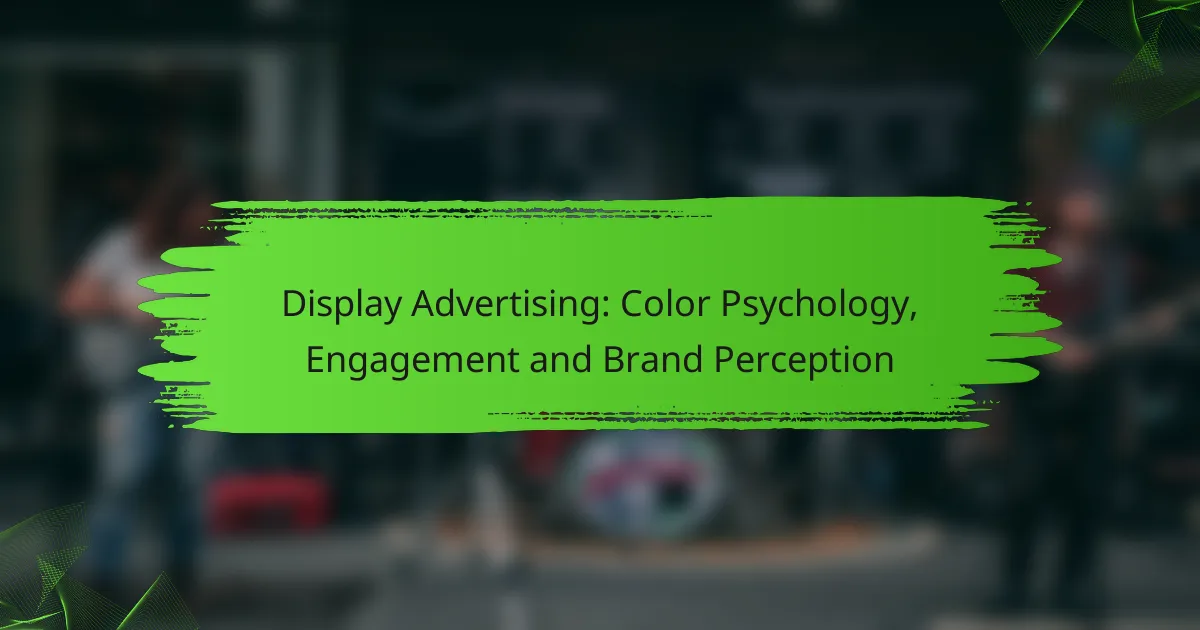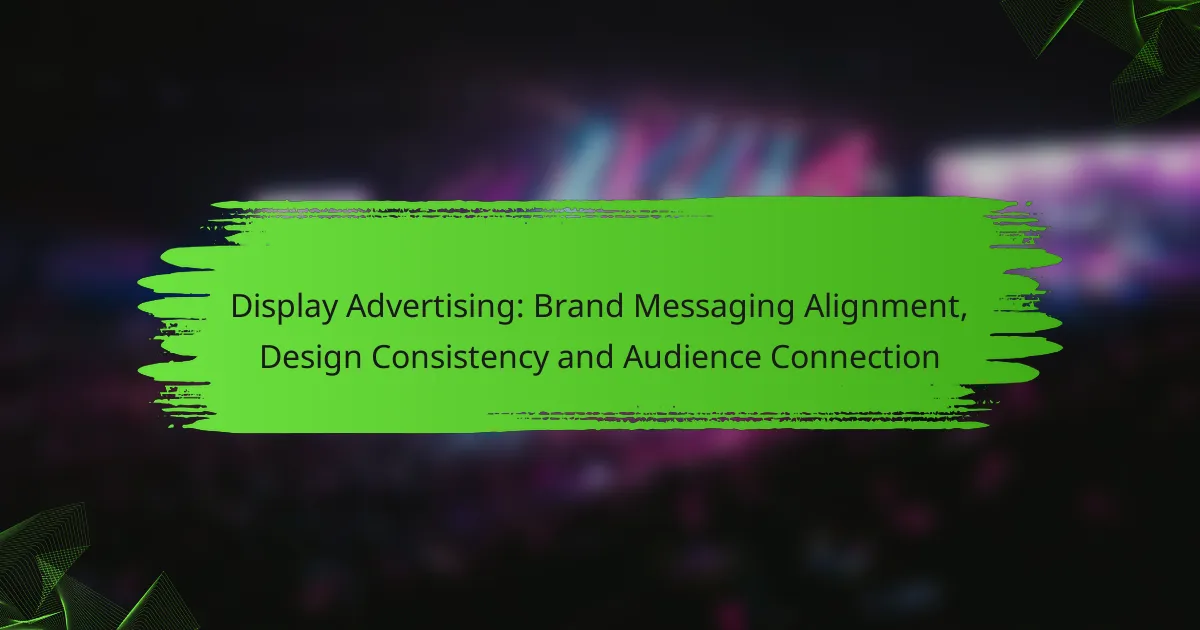Color psychology plays a crucial role in display advertising by shaping consumer emotions and brand perceptions. By strategically selecting colors that resonate with their target audience, brands can enhance engagement, evoke specific feelings, and influence purchasing decisions. Understanding the psychological impact of colors allows advertisers to create visually compelling campaigns that foster positive associations and strengthen brand identity.

How does color psychology impact display advertising?
Color psychology significantly influences display advertising by affecting consumer emotions and perceptions of brands. The right color choices can enhance engagement, evoke desired feelings, and ultimately drive purchasing decisions.
Influence of color on consumer emotions
Colors can evoke specific emotional responses, which can be leveraged in advertising. For example, blue often conveys trust and calmness, making it a popular choice for financial institutions. In contrast, red can evoke excitement and urgency, frequently used in clearance sales.
Understanding the emotional impact of colors allows advertisers to tailor their campaigns effectively. For instance, using warm colors can create a sense of comfort, while cooler tones may promote a feeling of professionalism. Selecting the right color palette can enhance the overall message of the advertisement.
Color associations with brands
Many brands have established strong color associations that help consumers identify them quickly. For example, Coca-Cola is synonymous with red, while Starbucks is often linked to green. These associations can enhance brand recognition and loyalty.
When creating display ads, it’s crucial to consider existing color associations within your industry. Aligning your color choices with these associations can strengthen your brand’s identity and make your advertisements more effective.
Case studies in color usage
Numerous brands have successfully utilized color psychology in their advertising strategies. For instance, McDonald’s employs red and yellow to stimulate appetite and attract attention. This combination has proven effective in driving foot traffic to their restaurants.
Another example is the use of blue by social media platforms like Facebook and Twitter, which fosters a sense of trust and security among users. Analyzing these case studies can provide valuable insights into how color choices can impact consumer behavior and advertising effectiveness.

What are effective color strategies for engagement?
Effective color strategies for engagement involve selecting hues that resonate with your target audience and enhance the overall user experience. By understanding the psychological impact of colors, brands can create visually appealing advertisements that capture attention and foster positive associations.
Warm vs. cool color palettes
Warm colors, such as reds, oranges, and yellows, tend to evoke feelings of excitement and energy, making them suitable for brands aiming to create a sense of urgency or enthusiasm. In contrast, cool colors like blues, greens, and purples promote calmness and trust, ideal for brands focused on reliability and professionalism.
When choosing between warm and cool palettes, consider your brand’s message and the emotions you want to elicit. For example, a fitness brand might benefit from warm colors to inspire action, while a financial service may prefer cool tones to convey stability.
Color contrast for visibility
High color contrast is crucial for ensuring visibility and readability in display advertising. Using contrasting colors for text and backgrounds can significantly enhance user engagement by making content easier to read and more visually appealing.
For effective contrast, aim for a difference of at least 70% in brightness between colors. Tools like contrast checkers can help ensure compliance with accessibility standards, making your ads more inclusive for all users.
Color trends in major markets
Color trends can vary significantly across different markets, influenced by cultural preferences and seasonal changes. For instance, in the United States, vibrant colors are often favored in summer campaigns, while muted tones may be more popular in winter.
In Europe, brands might lean towards earth tones that reflect sustainability, while in Asia, bright and bold colors are commonly associated with good fortune and prosperity. Staying informed about these trends can help brands tailor their advertising strategies to resonate with local audiences effectively.

How does color affect brand perception?
Color significantly influences brand perception by evoking emotions and associations that shape consumer attitudes. Different colors can convey various messages, impacting how a brand is viewed and remembered.
Color consistency across platforms
Maintaining color consistency across all marketing platforms is crucial for brand recognition. When consumers see the same colors in advertisements, websites, and social media, it reinforces their memory of the brand. Inconsistent use of colors can confuse potential customers and dilute brand identity.
To ensure consistency, create a brand style guide that outlines the specific color codes (like HEX or RGB values) and their applications. This guide should be shared with all teams involved in marketing and design to maintain a unified look.
Impact of color on brand loyalty
Color can significantly affect brand loyalty by fostering emotional connections with consumers. Brands that use colors aligned with their target audience’s preferences are more likely to cultivate loyalty. For instance, blue often conveys trust, making it a popular choice for financial institutions.
Research suggests that consumers are more likely to remain loyal to brands that consistently use colors that resonate with them. Therefore, understanding your audience’s color preferences can enhance customer retention and encourage repeat purchases.
Examples of successful brand color schemes
Several brands have effectively used color schemes to enhance their identity and market presence. For example, Coca-Cola’s iconic red evokes excitement and energy, while Starbucks uses green to symbolize growth and sustainability.
Another example is McDonald’s, which employs yellow and red to create a sense of happiness and appetite. These color choices not only reflect the brand’s values but also help in creating a memorable visual identity that resonates with consumers globally.

What frameworks exist for selecting colors in advertising?
Several frameworks assist in selecting colors for advertising, focusing on psychological impact and brand alignment. These frameworks help marketers choose colors that enhance engagement and positively influence brand perception.
Color selection matrices
Color selection matrices are tools that categorize colors based on their emotional and psychological associations. They help advertisers visualize how different colors interact and the feelings they evoke, enabling more strategic choices. For instance, a matrix might show that red conveys excitement, while blue suggests trust.
When using a color selection matrix, consider the target audience and cultural context. Different cultures may interpret colors differently; for example, white signifies purity in some cultures but mourning in others. This understanding can guide effective color choices that resonate with the intended demographic.
Psychological color wheel
The psychological color wheel is a visual representation that links colors to specific emotions and behaviors. It helps advertisers understand how colors can influence consumer reactions and decision-making processes. For example, warm colors like orange and yellow can stimulate appetite, making them ideal for food-related advertising.
Utilizing the psychological color wheel involves selecting colors that align with the desired emotional response. For effective advertising, consider combining colors that complement each other on the wheel to create a balanced and appealing visual. Avoid using clashing colors that may confuse or alienate the audience.

How can businesses measure the effectiveness of color choices?
Businesses can measure the effectiveness of color choices through various methods that assess user engagement and brand perception. Key approaches include A/B testing different color variations and utilizing analytics tools to track performance metrics.
A/B testing color variations
A/B testing involves comparing two or more color variations of an advertisement to determine which one performs better in terms of user engagement. For example, a business might test a red versus a blue call-to-action button to see which generates more clicks.
When conducting A/B tests, it’s crucial to ensure that the sample size is large enough to yield statistically significant results. Aim for a testing period of at least one to two weeks to account for variations in user behavior.
Analytics tools for color performance
Analytics tools can provide insights into how different colors impact user interactions. Platforms like Google Analytics allow businesses to track metrics such as click-through rates and conversion rates associated with specific color choices.
Consider setting up goals and funnels in your analytics tool to visualize how color variations affect user journeys. Regularly review this data to make informed decisions about color strategy in your advertising campaigns.

What are emerging trends in color usage for display ads?
Emerging trends in color usage for display ads focus on personalization, interactivity, and emotional engagement. Advertisers are increasingly leveraging color psychology to create more impactful and tailored experiences for consumers, enhancing brand perception and driving engagement.
Personalization through color
Personalization in display ads involves using color schemes that resonate with individual preferences and cultural backgrounds. By analyzing user data, brands can select colors that evoke specific emotions or associations, making the ad more relevant and appealing to the target audience.
For example, a brand targeting a youthful demographic might use vibrant colors like bright blues and greens, while a luxury brand may opt for muted tones like gold and navy. Testing different color palettes can help determine which combinations yield the highest engagement rates.
Augmented reality and color interaction
Augmented reality (AR) enhances color interaction in display advertising by allowing users to visualize products in their own environments. This technology enables consumers to see how different colors of a product would look in real life, increasing their confidence in purchase decisions.
Brands can utilize AR to create immersive experiences, such as virtual try-ons for clothing or makeup. Ensuring that the colors displayed are true to life is crucial, as discrepancies can lead to dissatisfaction and negative brand perception. Regularly updating AR content to reflect seasonal color trends can keep the advertising fresh and engaging.



